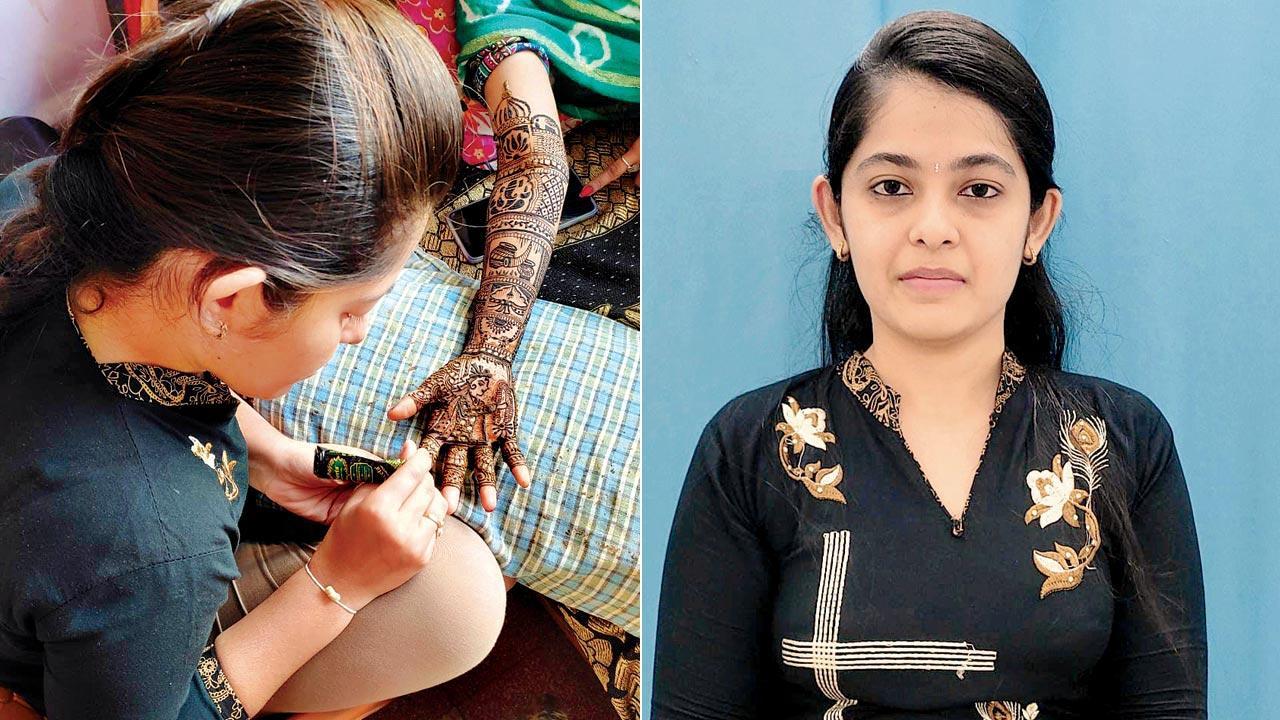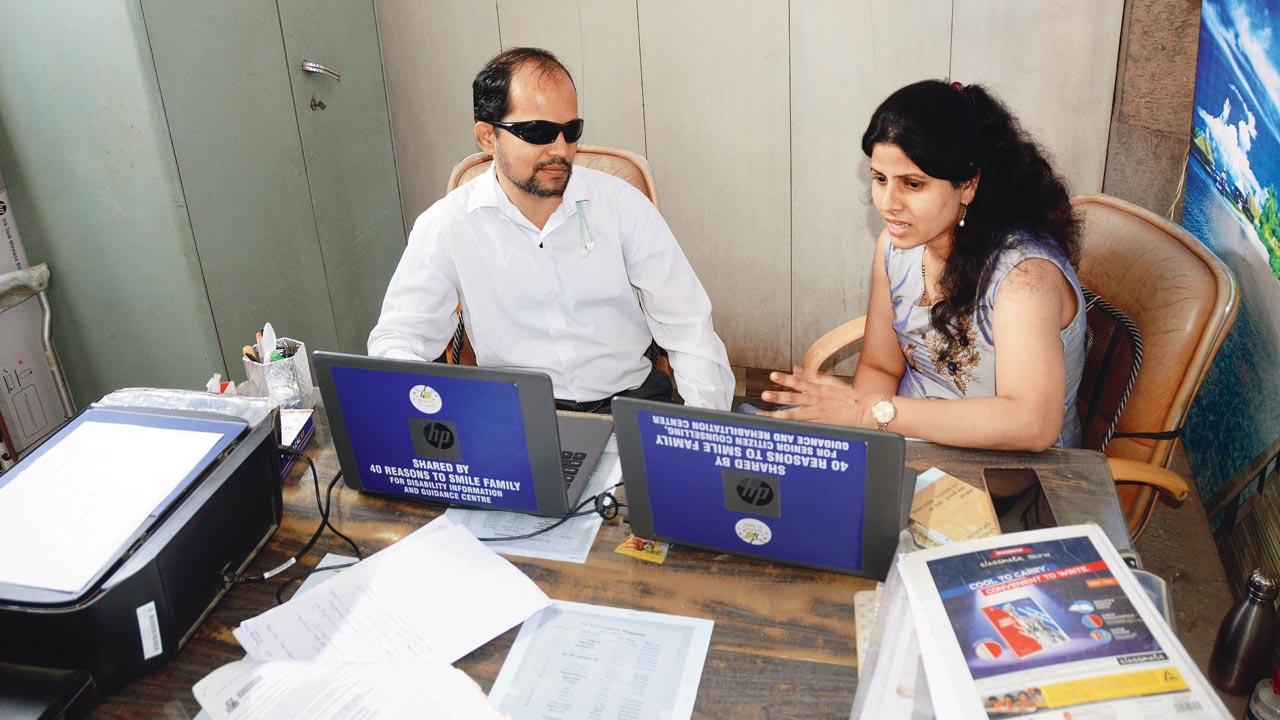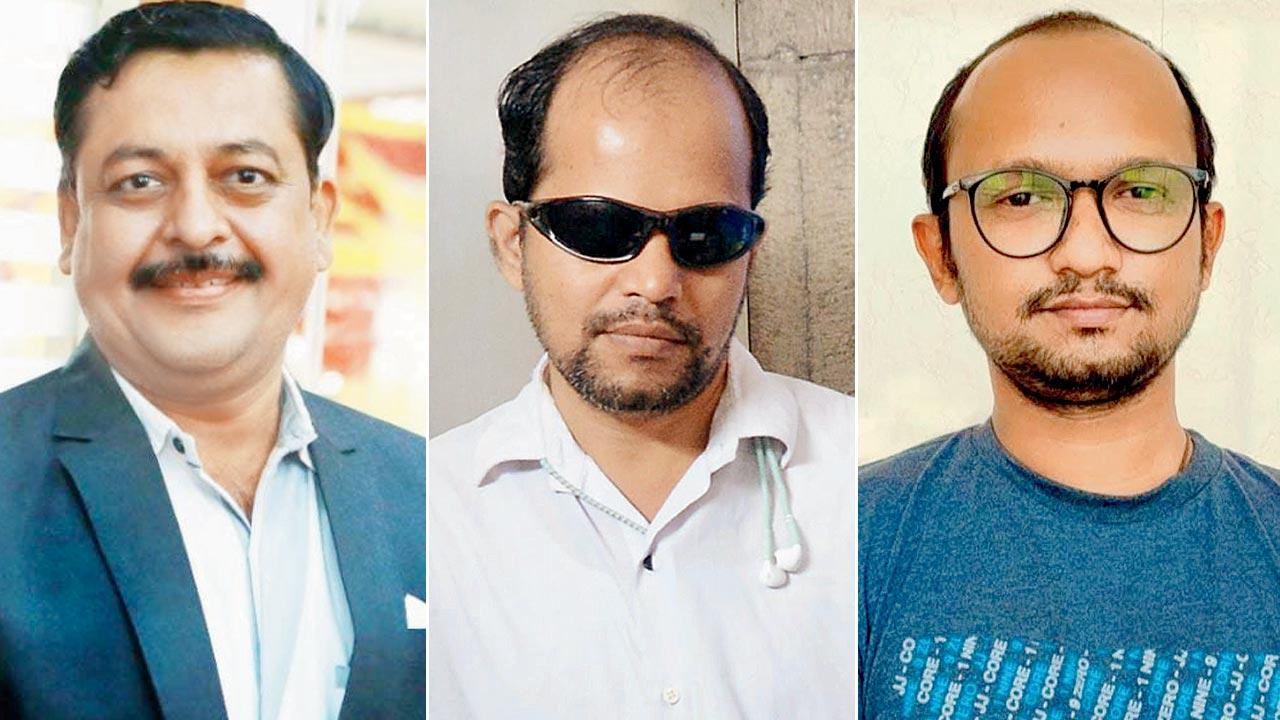For thousands of disabled people in Maharashtra, the prospect of acquiring an e-vehicle under the state government’s new social justice scheme remains unattainable. mid-day unearths old, new and bizarre bureaucratic hurdles and stories of humiliation

Riddhi Shah has numerous clients in her hometown Jalgaon; (right) Mehendi artist Riddhi Shah
Riddhi Shah has never truly experienced sound. The 24-year-old cannot respond to us verbally, but she can communicate effortlessly in a language she understands: the Indian Sign Language (ISL). Shah cannot hear traffic snarls, the clamour of hawkers, the sharp whistle of the police hawaldar on the roads of her hometown, Jalgaon (though horns are audible to her with the help of a hearing aid). But she can drive her two-wheeler across the city in a manner that outshines others.
ADVERTISEMENT
Yet, Shah doesn’t qualify for a licence issued by the Regional Transport Office, despite Section 8 of the Motor Vehicles Act, 1988 and a Bombay High Court
judgement–both of which, when read together, recognise her right to drive, according to the Union Road Transport Ministry. Such is the case with her parents, who, like Shah, have hearing disabilities.
It is also the reality of a majority of the 15 lakh deaf individuals in Maharashtra, per estimates by the State Level Association of the Deaf (SLAD). “I took the test and passed twice, once in 2018 and then in 2019. Even now, I have been asking transport officials where my licence is, but there is no clear response,” says Shah, with the help of a certified interpreter for this story, Tejal Patwari.
 Raju Waghmare helps scores of disabled individuals who arrive at JJ Hospital to obtain UDID cards. Pic/Sayyed Sameer Abedi
Raju Waghmare helps scores of disabled individuals who arrive at JJ Hospital to obtain UDID cards. Pic/Sayyed Sameer Abedi
Despite this she persists, zipping across Jalgaon on her two-wheeler with a bag full of mehendi cones. Shah’s clients are the numerous families of Jalgaon who hear of her skills through word of mouth. She is vital to their many celebrations, as she spends hours crafting intricate patterns on the palms of relatives and guests.
December 2023 saw the rolling out of a scheme by the state government’s Department of Social Justice and Special Assistance’s disability welfare division, promising an e-vehicle to persons with disabilities. The purpose behind this scheme was to facilitate self-employment. The e-vehicle in question resembles a rickshaw or mini-tempo, with a large compartmentalised storage space in the back. It will enable the disabled to take their services and businesses to different locations.
As of now, the budget for this seemingly promising scheme is R25 crore, per Abhay Kargutkar, the director of the Maharashtra State Handicapped Finance and Development Corporation (MSHFDC). Those with 40 per cent and more disability had until January 4 to avail of the scheme; the deadline was extended by an additional four days, and finally on January 9, the Department announced that registrations have been shut for the financial year 2023-24. The scheme will accept more applications only in April now, when the next financial year begins. It will now be an annual affair in a phased manner, says Kargutkar.
 Manoj Patwari, Raju Waghmare and Ketan Maru
Manoj Patwari, Raju Waghmare and Ketan Maru
Data on the application portal tells us that 45,389 people have registered themselves for the first round of the scheme. Most of these applicants live with locomotor disabilities, many of whom are issued a driving licence without much resistance by officials.
The vetting of these thousands of applications is based on the 13-point terms and conditions specified by the Department. In all, only 667 of those who have applied—a mere one per cent—will receive the vehicle. “Allotment will be in accordance with the percentage of disability,” Kargutkar says, “Those who qualified but did not make it in the first round will have their applications moved ahead for consideration in the second round.”
Additionally, the government has put a cap on the number of vehicles that can be distributed in each district. This figure will be in proportion to the population of people with disabilities in that particular district, as per the last released data. Notably, neither of these conditions have been mentioned on the website.
When questioned about the disproportionate number of disabled people applying for the scheme, as compared to their population, the director of MSHFDC defended the figures. The reason, Kargutkar says, is because the scheme is only applicable to those between the ages of 18 to 55.
According to the NSS, those who are 60 and above make up only 6.3 per cent of the total population of persons with disabilities. “Chief Minister Eknath Shinde is closely monitoring this scheme. He tells us the work we are doing is auspicious,” says the MSHFDC director, adding that the government resolution for the scheme was issued in 2019, but its implementation started only last month.
WhatsApp groups with 3,000 members of the deaf community came abuzz in December, soon after the announcement of the scheme. This is how Shah learnt of this new and attractive promise. She’s been a mehendi artist since she was a teen; now in her early 20s, she earns Rs 10,000 each month during the rest of the year, and twice as much during wedding season. For her, the scheme brought with it the hope of expanding her business and new ideas about setting up a travelling shop of her own, where she could readily showcase her designs and amass more returns.
When the time came to fill up the application for the scheme, there was only one thing standing in her way: Its terms and conditions required disabled persons to have driving licences. If not, one could still avail of the scheme on the condition that there would be another person with a driving licence handling the vehicle at all times. Discouraged, Shah did not move ahead with her application.
Another criterion of the scheme mandates that applicants should be holders of a unique disability identity card (UDID) with an annual income of not more than R2.5 lakh. Disabled individuals like Shah obtain this card despite the complex web of bureaucracy that surrounds its procedures, and the multiple rounds of government-run or municipal corporation-run hospitals one has to make. It is not uncommon for people to be passed on, from one hospital to the next, from one department to another, from one doctor to a second and third.
In the end, says Raju Waghmare, there is still no guarantee that the card will reach the doorsteps of the applicant. “They should not have included the UDID as a condition if they wanted a large number of people to avail of it,” the visually impaired social worker at JJ Hospital says to mid-day.
“A disability certificate should have sufficed.”
At present, applications are processed further even without UDIDs, only to be rejected at a later stage. Kargutkar says the Department is considering tweaking the application portal to make the UDID mandatory so the form doesn’t proceed in the first place.
According to disability rights activists, the number of people who possess these cards make up a very small minority of the community across the country. The Parliamentary Standing Committee on Social Justice, in its report tabled in the Lok Sabha last July, notes that the Department of Empowerment of Persons with Disabilities has issued only a little over 94.09 lakh UDIDs since 2017. Even a decade ago, the population of persons with disabilities was twice that number, the Committee said.
In Waghmare’s opinion, it is the crucial importance given to the UDID that has excluded a large number of people. “Disability certificates can be forged; there have been instances where abled individuals have secured jobs on the basis of a fake certificate. We have made the UDID a must to avoid such situations,” says Kargutkar, even as he acknowledges the limited reach of the digital ID.
Whether it is UDID cards or driving licences, for the deaf, the road to availing entitlements is paved with mockery and humiliation in government offices, says Ketan Maru. “There are no interpreters; the officials expect us to talk. They insist that we can’t hear but can speak, which is not always the case,” the Mumbai-based Zomato delivery agent explains.
As a result, the deaf are often accompanied by family members who translate sign language into verbal communication. Data from the Indian Sign Language Research and Training Centre under the Social Justice Department tells us that India has 325 interpreters, of which only 263 are active, and 35 of them are located in Maharashtra. Most of these 35 interpreters are concentrated in and around Mumbai, with a few in Pune.
At the nearly 200-year-old JJ Hospital, where thousands of disabled individuals across Maharashtra come to obtain UDID cards, Waghmare helps them navigate the process—and sometimes, that comes at a cost. “There is no interpreter here. Their fees can surpass Rs 1,000 per hour. I make video calls to an interpreter when deaf individuals visit the office. But their fees come directly from my pocket.”
Manoj Patwari, 53, runs the WhatsApp group for the deaf that Maru and Shah are part of. The Jalna resident, who serves as president of the State Level Association of the Deaf, points out the ironic outcome of poor advertisement of government policies like the e-vehicle scheme: they exclude the deaf community because they are not widely available through a visual medium. “I am in frequent communication with officials, which is why I know about them [schemes], but that is not the case with everyone. I relay the information ahead to the small number of deaf people in my WhatsApp groups,” he says.
Meetings have been held between the disability bodies and transport officials, where the latter expressed reluctance in providing a driving licence to the deaf, citing safety concerns. Mumbai-based Taslim Sheikh, whose husband has a hearing disability, is another of the few certified interpreters in India. “He was denied a driving licence initially. It was only after he visited the RTO office with a set of legal documents, highlighting the rules that allowed licences for the deaf, that the process moved forward,” she says.
Patwari insists that the fairness of the conditions in the e-vehicle scheme are contextual and differ according to specific disabilities. Waghmare, for one, is relieved that there is a provision for an escort or a helper to handle the vehicle in the absence of a driving licence. This provision effectively opens it up to hundred per cent visually-impaired individuals like him.
But it does not serve the deaf, says Patwari, who raises a pertinent question to which officials have no answer: Why should a deaf individual depend on a helper if they can drive with ease, and the law allows them to do so? “We are willing to accept the condition if the government pays for the helper,” Patwari asserts. When Kargutkar was told about this potential bargain, he responded by saying, “What matters is that this free-of-cost scheme is a start. It will be improved upon as we progress.”
Since the scheme remains far beyond her reach, Shah suggests an alternative—one with fewer stringent terms and conditions, that includes all people with disabilities. Such as access to commercial properties in locations which see significant footfalls.
Until then, she will continue to use her two-wheeler to take her mehendi business far and wide. “I have been caught [by the traffic police] a few times. It takes some effort to make traffic hawaldars realise that I am deaf. Sometimes, I write on a piece of paper if they do not understand my signs. But I have never been fined,” she says.
667
No. of applicants to the scheme who will receive e-vehicles, from a total of 45,389
Rs 25 cr
Budget of scheme to provide e-vehicles to disabled individuals
Hidden figures
. There’s a dearth of reliable government data on the population of persons with disabilities in both Maharashtra and India. The union government estimates of the population with disabilities still rely on the 2011 Census, which states that out of the 121 crore citizens at the time, India was home to 2.68 crore persons with disabilities (2.21 per cent of the total population).
Similar figures appear in the 76th round of the National Sample Survey conducted between July 2018 to December 2018, which estimates the population to be 2.2 per cent of India’s total at the time, with 2.3 per cent residing in rural areas and 2.0 per cent in urban areas. In Maharashtra, the same NSS estimates 1.9 per cent of the population lives with disabilities, with 2.1 per cent in rural areas and 1.6 per cent in urban areas.
. On the other hand, the latest National Family Health Survey (NHFS-5) takes the countrywide figure down a few notches, reporting that there were only one per cent of people with disabilities in the years 2019 and 2021.
. These figures have been disputed by members of the disabled community, who state that the methodology is flawed, and that the numbers exceed what the government estimates. The Parliamentary Standing Committee on Social Justice, too, challenged the numbers in its report tabled in the Lok Sabha last July.
 Subscribe today by clicking the link and stay updated with the latest news!" Click here!
Subscribe today by clicking the link and stay updated with the latest news!" Click here!







